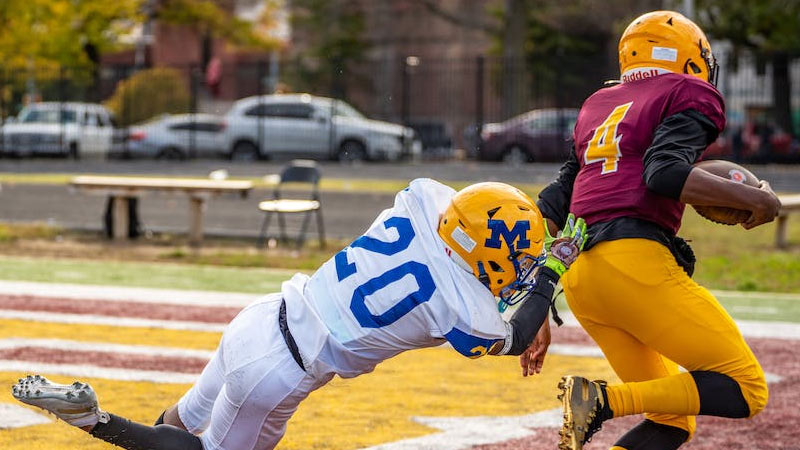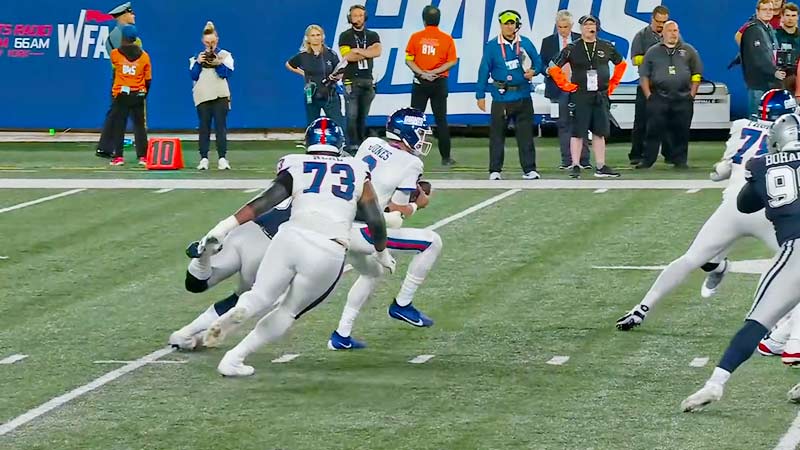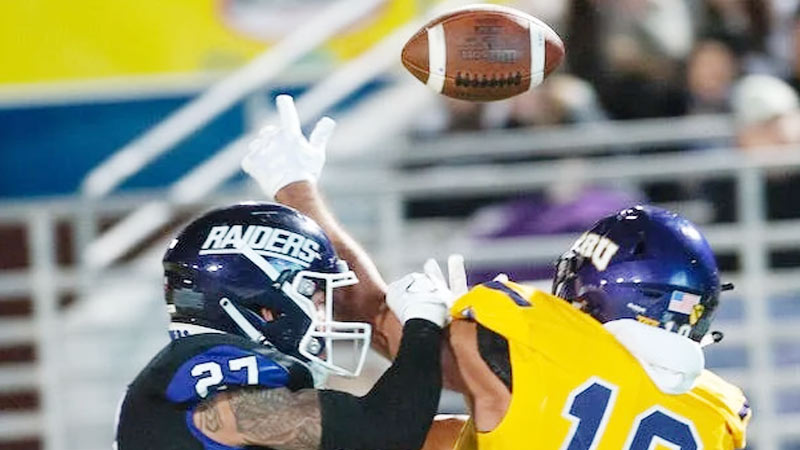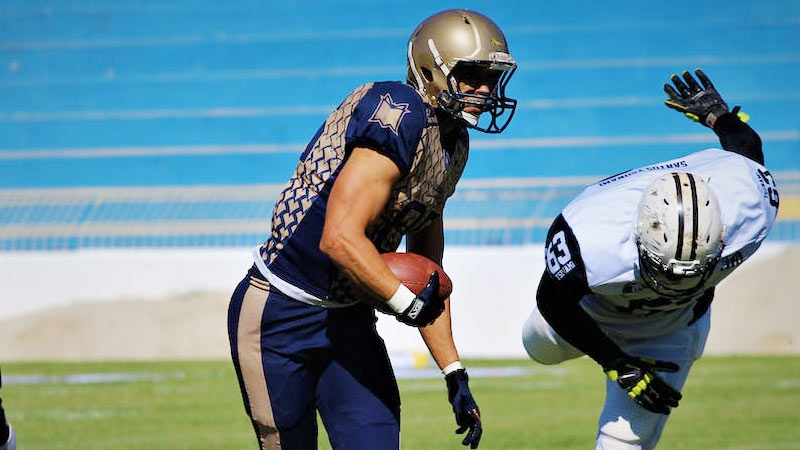Football is a game of intricate strategies and dynamic plays, where both offense and defense engage in a battle of wits and athleticism. Among the many defensive maneuvers that can turn the tide of a game, “deflecting” stands out as a skillful and impactful technique.
In this blog post, we’ll delve into the world of football and explore the concept of deflecting in football – what it means, how it’s executed, and its significance on the field.
Whether you’re a seasoned football enthusiast or a newcomer to the sport, read on to unravel the mysteries behind this essential defensive play. So, stay focused.
What Does Deflecting Mean in Football
In American football, the term “deflecting” refers to a defensive player’s action of preventing a pass from being completed by interfering with the trajectory of the football.
A deflection occurs when a defensive player uses their hand or part of their arm to slap or block the ball while it’s in the air, altering its path and ultimately causing the pass to fall incomplete.
This defensive maneuver is also known by various terms, such as a “pass deflection,” “pass defended,” “pass knockdown,” or “pass breakup.”
Deflecting a pass is a critical skill employed by defensive players, primarily defensive backs and linebackers, whose main objective is to disrupt the offensive play and prevent the intended receiver from making a catch.
By effectively deflecting the ball, the defensive player aims to deny the offense the opportunity to advance the ball down the field and potentially score points. The technique of deflecting involves timing, anticipation, and coordination
When Does Deflecting Happen in Football?

Deflecting in football, specifically in American football, happens during passing plays when the defensive player interferes with the trajectory of the ball while it’s in the air, preventing the intended receiver from making a catch. This defensive maneuver typically occurs in the following situations:
Passing Plays
Deflecting primarily takes place during passing plays when the offensive team attempts to advance the ball down the field by throwing it to a receiver.
Defensive players, such as cornerbacks, safeties, and linebackers, are responsible for covering the receivers and tight ends, aiming to disrupt the pass and prevent successful completions.
Coverage
When a defensive player is in tight coverage with an offensive player, they position themselves between the receiver and the quarterback. This positioning allows them to react to the quarterback’s throw and use their hands or arms to block or alter the trajectory of the ball, causing it to become incomplete.
Anticipation
Skilled defensive players use their football IQ and awareness to anticipate the intended target of a pass. By reading the quarterback’s eyes, body language, and offensive formation, they can predict the direction of the pass and position themselves accordingly to make a deflection.
Timing
Timing is crucial for a successful deflection. Defensive players need to time their jump or movement precisely to meet the ball in the air. If their timing is off, they might miss the ball or inadvertently make contact with the receiver, which could result in a penalty.
Breakups and Interceptions
Deflections can lead to either incomplete passes or interceptions. If a defensive player deflects the ball into the air and it remains up for grabs, other defensive players might have an opportunity to intercept it before it hits the ground.
Red Zone Situations
Deflections are particularly critical in the red zone (the area close to the opponent’s end zone). Here, the field becomes compressed, making it more challenging for offenses to execute passing plays successfully.
Deflections become a potent tool for defensive players to deny touchdowns and force field goal attempts.
Is There Any Rule Regarding Deflection in American Football?
Yes, there are rules in American football that pertain to deflections and defensive actions during passing plays. Some of the key rules and considerations regarding deflections include:
Pass Interference

While deflections are legal defensive actions, it’s important to note that there are rules against pass interference. Pass interference occurs when a defensive player hinders the receiver’s ability to catch a pass through actions like contact, pushing, or holding.
If a defender makes contact with a receiver before the ball arrives and significantly hinders the receiver’s ability to make a play on the ball, it can result in a pass interference penalty.
Contact Timing
Defensive players must time their attempts to deflect the ball properly. Contact made after the ball has arrived and is in the process of being caught by the receiver is generally legal, as long as it’s not excessive or unnecessarily rough. However, early contact with the receiver can lead to penalties for interference.
Deflection and Interception
If a defensive player deflects the ball into the air and another player on the defensive team catches it before it touches the ground, it’s considered an interception. The defensive team gains possession of the ball at the spot of the interception.
Defensive Holding
While not directly related to deflections, defensive holding is another penalty that can occur during passing plays. If a defensive player holds or restricts the movement of an offensive player, it can result in a penalty.
Illegal Use of Hands
Defensive players must avoid using their hands to the face, neck, or head of an offensive player, as it can result in penalties for illegal use of hands or unnecessary roughness.
Roughing the Passer
After the quarterback has released the ball, defenders are not allowed to make unnecessary or excessive contact with the quarterback. This rule is in place to protect the quarterback from injury.
It’s important for defensive players to be aware of these rules and to execute their defensive techniques in a legal and safe manner.
Penalties resulting from rule violations can have significant impacts on the course of a game, potentially benefiting the offense with yardage gains and first downs.
Result of Deflection in Football

The result of a deflection in football, particularly American football, can vary depending on the specific circumstances of the play and the actions that follow the deflection. Here are some potential outcomes that can result from a deflection:
Incomplete Pass
The most common outcome of a deflection is an incomplete pass. If a defensive player successfully deflects the ball and prevents the intended receiver from making the catch, the pass is considered incomplete. This results in the down being replayed with the same yardage as before the play.
Interception
If a defensive player deflects the ball into the air, and another player on the same defensive team catches the deflected ball before it touches the ground, it’s considered an interception. The defensive team gains possession of the ball at the spot of the interception.
Turnover on Downs
If the deflection occurs on a fourth down play and the offense fails to convert the necessary yardage, the turnover on downs gives possession of the ball to the opposing team at the spot of the deflection.
Field Position
Depending on where the deflection occurs on the field, it can impact the starting field position for the subsequent drive. A deflection that occurs deep in the offensive territory might result in a better field position for the defense, giving them a shorter distance to cover to reach the end zone.
Scoring Opportunity
In some cases, a deflection can lead to immediate scoring opportunities for the defense. If a deflected ball is caught for an interception, the defensive player might be able to return the ball for a touchdown or set up the offense with a favorable field position for a potential scoring drive.
Down and Distance
An incomplete pass due to a deflection can affect the down and distance situation for the offense.
If the deflection occurs on the first down, for instance, it leads to a second downplay with a new set of downs. If it occurs on third down, the offense may need to decide whether to attempt a field goal, punt or go for it on fourth down.
Impact of Deflection on Football

The impact of a deflection in football, particularly American football, is multifaceted and can significantly influence the course of a game. Here are some key ways in which deflections can have an impact:
Disruption of Passing Rhythm
Deflections disrupt the timing and rhythm of the offensive passing game. By preventing the intended receiver from making a catch, the defense can disrupt the execution of the play and force the offense to recalibrate its strategy.
Preventing Completions
The primary goal of a deflection is to prevent the completion of a pass. This can lead to incompletions, which can be frustrating for the offense, and force them into more challenging down-and-distance situations.
Turnovers
If a deflected pass is intercepted by a defensive player from the same team, it can result in a turnover. Interceptions can provide the defensive team with a sudden change in possession and potentially lead to scoring opportunities.
Field Position Swing
Deflections that result in incompletions can impact field position. For instance, a deflection near the opponent’s end zone can lead to poor field position for the offense, making it harder for them to move the ball down the field.
Momentum Shift
A timely deflection, especially one that leads to an interception or an incompletion on a critical down, can shift the momentum of the game in favor of the defensive team. This can energize the defense, the team’s sideline, and even the crowd.
Red Zone Impact
In the red zone, where teams are close to scoring, deflections become even more critical. Preventing a completion in this area can force the offense to settle for a field goal attempt instead of a touchdown.
Turnover Points
If a deflection leads to an interception or fumble recovery by the defense, it can directly result in points. Interceptions returned for touchdowns or fumbles recovered deep in the opponent’s territory can lead to immediate scoring opportunities.
Pressure on Quarterback
The threat of deflections can put additional pressure on the quarterback to make accurate throws. This pressure can force the quarterback into making quicker decisions, potentially leading to rushed or inaccurate passes.
Defensive Confidence
Successfully deflecting passes can boost the confidence of defensive players. It demonstrates their ability to impact the game and disrupt the offense’s plans, fostering a sense of teamwork and accomplishment.
Strategic Adjustments
The offense might need to adjust its strategy if deflections are becoming a recurring issue. This could involve changing the routes, timing, or targets to counter the defensive tactics.
FAQs
What does “deflecting” mean in football?
Deflecting, in the context of football, refers to a defensive player’s action of preventing a pass from being completed by interfering with the ball’s trajectory. This is achieved by slapping or blocking the ball with a hand or part of the arm, causing it to fall incomplete and disrupting the offensive play.
Who typically executes deflections on the field?
Deflections are most commonly executed by defensive players, such as cornerbacks, safeties, and linebackers. These players are responsible for covering receivers and tight ends, using their skills and timing to deflect passes and disrupt the offensive game plan.
What are the different terms used to describe deflections?
Deflections are known by various terms, including “pass deflection,” “pass defended,” “pass knockdown,” “pass breakup,” and “pass defended.” These terms all refer to the act of a defensive player preventing a pass from being completed through physical interference.
How does timing play a role in successful deflections?
Timing is crucial for successful deflections. Defensive players must anticipate the quarterback’s throw, gauge the trajectory of the pass, and time their movement to meet the ball in the air.
Proper timing allows them to alter the ball’s path effectively and minimize the chances of a completed pass.
What are the potential outcomes of a successful deflection?
A successful deflection can lead to multiple outcomes. The most common result is an incomplete pass, disrupting the offensive play.
In some cases, a deflected pass can lead to an interception if another defensive player catches the ball before it hits the ground. Additionally, deflections can impact field position, momentum, and the offensive team’s strategic decisions.
Wrapping Up
In the dynamic world of football, where every yard gained and every play executed can make the difference between victory and defeat, the art of deflecting emerges as a pivotal defensive strategy.
By understanding the nuances of deflections—how they’re executed, their impact on the game, and the various terms associated with them—fans and players alike gain a deeper appreciation for the complexity and excitement that define the sport.
As defensive players strive to master the art of deflection, they contribute to the rich tapestry of football, shaping its narrative one deflected pass at a time. Thank you.







